Facial Eczema
Facial eczema (FE) is a disease of sheep, cattle, deer and alpacas. It can cause death, photosensitization and lowered production as a result of liver injury, and is mainly seen during periods of warm humid weather between January and May.
The pasture fungus Pithomyces charatarum multiplies and produces spores, which contain the toxin Sporidesmin. Sporidesmin causes injury to the liver. The bile ducts become thickened and may be completely blocked. The damaged liver cannot rid the body of wastes and a breakdownproduct of chlorophyll accumulates in the tissues and causes sensitivity to sunlight.
Sunlight causes immediate and severe skin inflammation to exposed parts of the body.The symptoms of FE therefore can vary from severe photo-sensitisation and in some cases death to sub-clinical effects on the production of meat, wool and milk. In any FE outbreak, many animals with liver damage show no clinical signs – but they suffer from subclinical FE.
Photosensitisation tends to occur about 2 weeks after exposure to spores and is characterised by irritation, reddening and oedema (puffiness) of exposed hairless or non-pigmented skin. This is followed by serum ooze and ultimately large sheets of skin may slough. Many animals affected by FE do not show outward signs; in fact only about 20% of animals with FE show skin signs. There will however, be some degree of liver damage and overall wellbeing will be compromised.
For rapid growth and spore formation the fungus needs warm, moist conditions common during the autumn. 4-5mm of rain or even heavy dews in conjunction with 2-4 nights when grass minimum temperatures remain above 12 degrees Celsius are sufficient to initiate rapid increases in spore numbers. Spore counts rise even more rapidly when minimum temperature of the grass is high (15-16⁰C) and associated with high humidity and/or light rain. Generally it takes two or three such “danger” periods before spore numbers reach dangerous levels, each spore rise providing the base for the next increase in spore numbers. However prolonged periods of warm, humid weather early in the season can accelerate the onset of toxic pastures.
Predicting and identifying danger periods by monitoring spore countsThe control of FE includes:
- Spraying pastures with fungicide to prevent spore growth
- Administering zinc
Cambridge Veterinary Services provides a daily spore count service through the eczema season. Grass samples are submitted to the clinic and results are reported to the owner the same day. The data is then collated as part of the ongoing monitoring service that we provide and is updated frequently on our website. Spore count information can be obtained by calling the clinic or from the website / Facebook page.
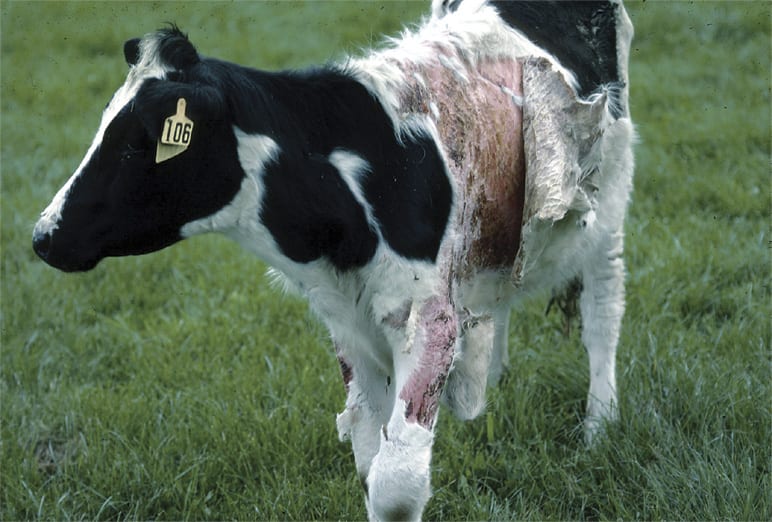
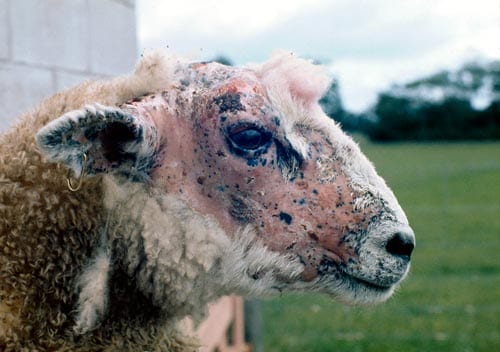
Prevention Options
Zinc can be administered in a number of ways:
- Zinc sulphate through the water trough
- 60% effective
- Not very palatable – flavourants required
- Needs to be gradually introduced over time
- No access to alternative water sources
- Not suitable for providing protection in a “crisis” period
- Zinc oxide oral drench
- 75-80% effective
- Zinc bullet
- 90% effective
- Great for young stock
- Slow release over a period of time
- Faceguard or Time Capsule
- Repeat administration required – usually 2-3 times in Waikato
- Pasture Spraying
- Please contact us for details on this procedure eg how much zinc oxide to use for pasture spraying. Pasture spraying with fungicides including “Xspore” and new “Mycotak /Mycowet” system is also possible. This is the best option for owners of Alpacas. Please enquire about these
Timecapsules
Faceguard Vs. Time Capsule
Both zinc bullets are inserted orally via a gun and sit within the rumen releasing a continuous, controlled amount of zinc over a period of time. It is highly effective and safe in most situations.
Time Capsules
Boluses contain compressed zinc oxide surrounded by a green shell of beeswax. The products come in a number of sizes according to the weight of the animal and requires repeat application every 4-5 weeks in cattle (4 weeks when counts are high) and will provide protection for six weeks in sheep and lambs.
The disadvantage with Time Capsules as you are probably aware, is the products fragility. If the green beeswax outing coating is damaged in any way the product cannot be used as there is a risk of zinc poisoning, which can be fatal.
Faceguard boluses contain compressed zinc metal. Faceguard
In contrast to Time Capsules’, Faceguard bullets are extremely robust and can handle being dropped. They are less likely to cause toxicity issues compared to the Time Capsule (whose outer wax coating can be damaged by teeth at insertion which means it is digested faster and not provide protection for 4 weeks).
The faceguard bullet comes in only one size so if the animal is bigger then you adjust the number of bullets given. A special gun is used (different to the Time Capsule gun) and is loaded with more bullets for heavier calves rather than having to have several different sized heads with the Time Capsule. A maximum of 5 bullets can be inserted into the gun. A single treatment will last 6 weeks (as opposed to 4 weeks) and re-treatment can extend this out to either 10 or 12 weeks.
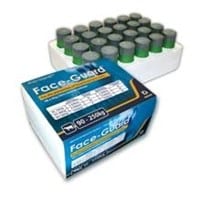
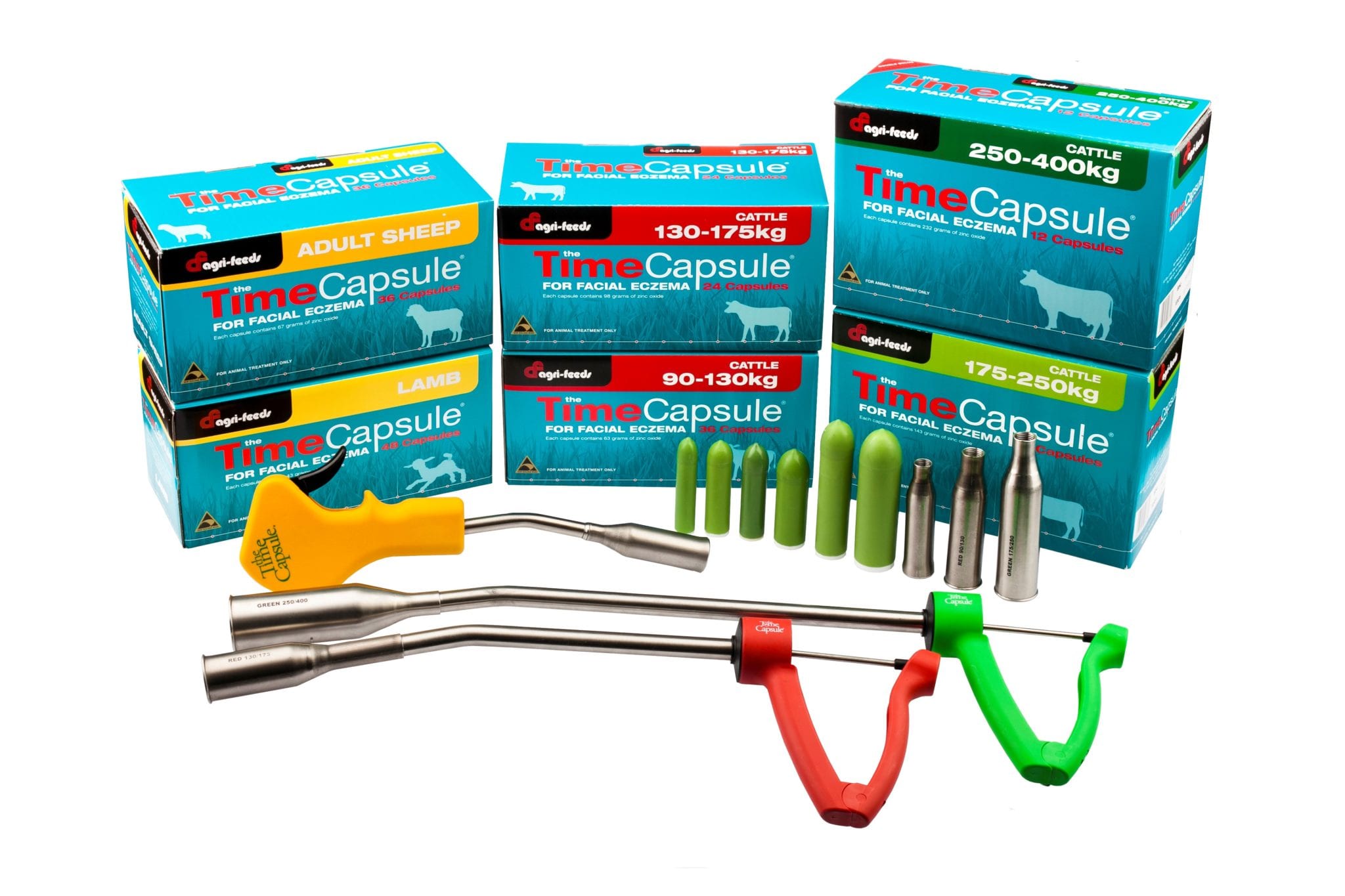
Cattle Zinc Drenching
Long Term Dosing Stabilised Drench eg Global Supa-Zinc
Mix 1 kg zinc oxide powder (Nu Zinc) with 1 litre of water (if not a stabilised
product add 200mls of stabiliser and 800 ml water).
• Mix water and stabiliser first if using.
• Sprinkle powder on the water and leave to settle and wet.
• Stir to a creamy paste.
• Daily dosing 3.5 mls per 100 kgs live weight
• 3-day dosing 13 mls per 100 kgs live weight.
• Weekly dosing 30 ml per 100 kgs live weight
Crisis dosing (only when spore counts are high), without previous long term dosing, gives less protection than long-term dosing and requires higher dose rates for protection over short periods. Stabilized drenches: 5ml/100kg live weight
Approximate dose volumes: Long Term Dosing
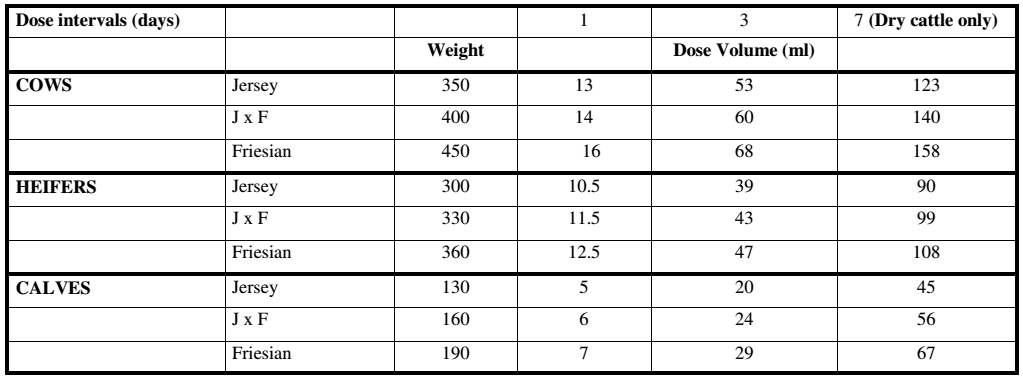
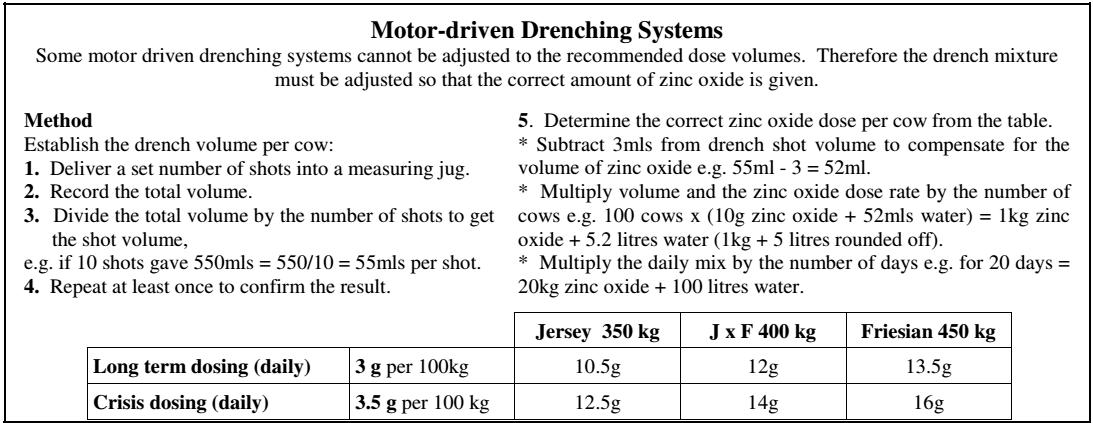
Zinc Sulphate in drinking water
There are four main methods of adding zinc to the drinking water of cattle.
1 . Using an in-line dispenser to add a concentrated solution of zinc sulphate into the water reticulation system. Important points to remember:
• Set a level to which you will fill the reservoir containing concentrated zinc solution
• Adjust the dispenser or the reservoir volume to ensure that each day half to two thirds of its solution is injected into the water supply.
• Calculate the amount of zinc to be added each day (see table). Multiply the dose rate for each class of stock by the number then work out the daily requirement.
• At the same time each day add the total daily amount of Zinc Sulphate to the concentrate reservoir and then dilute with water to the FULL line. Stir to dissolve the zinc as you fill.
2. Adding Zinc Sulphate to a large tank (e.g. 22 000 litres, or 5 000 gals) which supplies the water reticulation system. The Zinc Sulphate is added to a large reservoir tank. The tank must contain at least 100 litres for every cow or cow equivalent. Remember the Zinc Sulphate should be added about the same time each day. Zinc Sulphate should be dissolved in water before adding to the tank.
3. Floating trough dispensers (Peta dispensers). Although not as reliable as the first two systems these still appear to give reasonable results and are ideal in situations with smaller numbers
4. Direct addition to the water trough – this will only cope with very small numbers of animals.
Note -1.The addition of Zinc Sulphate to the water supply is only suitable to long-term routine dosing – it is not suited to crisis dosing during danger periods. Make sure zinc is only distributed to stock. Household and shed water needs to be kept separate. Make sure that livestock do not have access to alternative fresh water during the period that zinc is being added.
Addition to the water may be unreliable for treating animals not milking.
2. Mixing of other products in water (eg nutrimol) can reduce effectiveness by settling out the zinc in water lines. This may eventually block the lines and severe FE may result.
How to start:
Cows should be introduced to increasing zinc concentrations in water over a period of about 3-5 days.
There are two forms of zinc sulphate available; heptahydrate is commonly available, monohydrate is more concentrated and is used at 2/3 the dose of heptahydrate.
Troughs on the reticulated system in paddocks that have not been grazed should be primed with zinc sulphate at the rate of 1g/L (0.7g monohydrate per litre).
Once calibrated a volumetric measure is sufficiently accurate for regular use. Weigh out the required zinc sulphate into a plastic bucket. Level the surface and mark the height, fill the bucket to this level each day.
Concentrated zinc sulphate solutions are caustic. Avoid direct contact and wear protective goggles.
Be sure to follow the mixing instructions with all zinc products, in particular adding mono-zinc to water not the water to the powder.
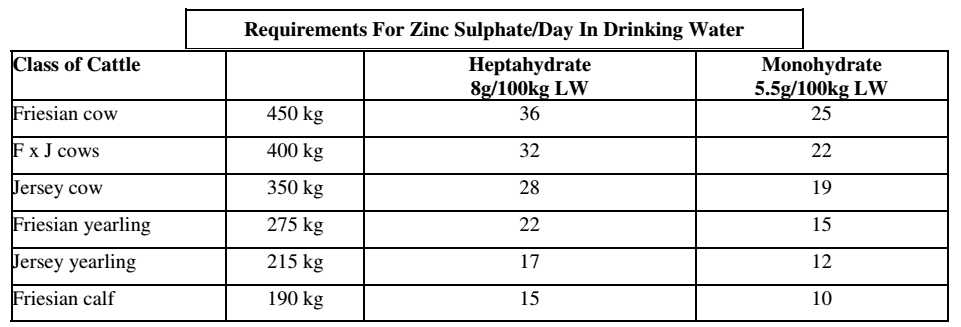
DEER
Red deer are more susceptible to FE than cattle. Fallow deer are more susceptible than sheep so they need more protection than Reds.
Prevention options include:
Spraying pastures with fungicide – Regular spraying with fungicides provides the most appropriate control method for preventing FE in deer. Start the spraying programme early while spore counts are low.
Zinc – the effectiveness and safety of zinc as a prevention has not been researched. If used, dose rates as for sheep (Fallow deer) and cattle (Red deer) should be followed. Because of low water intake, zinc in drinking water is not highly effective but will help in some situations.
Provide supplementary feed – such as hay, silage, meal or crop
SHEEP
Grazing Management
Planned grazing can substantially reduce the risk of FE in hill country. Good planning is essential and it must start months in advance.
Identify the safe areas on your farm and aim to have a feed bank on these areas for the FE season. The best way to identify the safer areas on your farm is by regular spore counting over several years – but in the meantime the shady south facing faces are generally safest.
The spores are concentrated in the litter at the base of the pasture so the harder the sheep
graze the greater the risk of FE.
Try to minimise the number of young stock retained to late summer and autumn.
Breeding for Resistance in Rams
Tolerance to FE is strongly inherited so sourcing rams tolerant to FE will reduce the susceptibility of their offspring to FE
Sheep can be dosed at twice weekly, weekly or fortnightly intervals with Zinc Oxide. However the longer the interval, the lower the level of protection. Salmonellosis has been
associated with fortnightly dosing so if this is a potential problem shorter intervals are recommended. Watch for diseases like pink eye and pneumonia, which may also develop due to frequent yarding.
RECOMMENDED DOSE RATES:
Stabilised drench – 0.5ml/1 0kg LW x interval (days) (recipes for mixing these drenches are in the cattle section).
GOATS
Goats are generally more resistant than sheep and their browsing habits make them less prone to ingesting spores. Milking goats are probably at greatest risk. Prevention is best achieved by never making stock graze into the base level of pastures. The fungus grows on the litter at the base of the pasture and the spores are concentrated there. Other options include:
Spray pasture with fungicide
Provide supplementary feed (crops, fodder, hay, silage)
Zinc prevention – in highly toxic conditions use zinc oxide as for sheep
Take home message
FE is a debilitating disease of livestock that can be largely prevented through knowledge of the disease and prophylactic administration of zinc at strategic times of the year. Start monitoring spore counts in December and institute preventative measures when conditions favour the proliferation of spores. If in doubt, be sure to contact your veterinarian to discuss the right approach for your animals.
